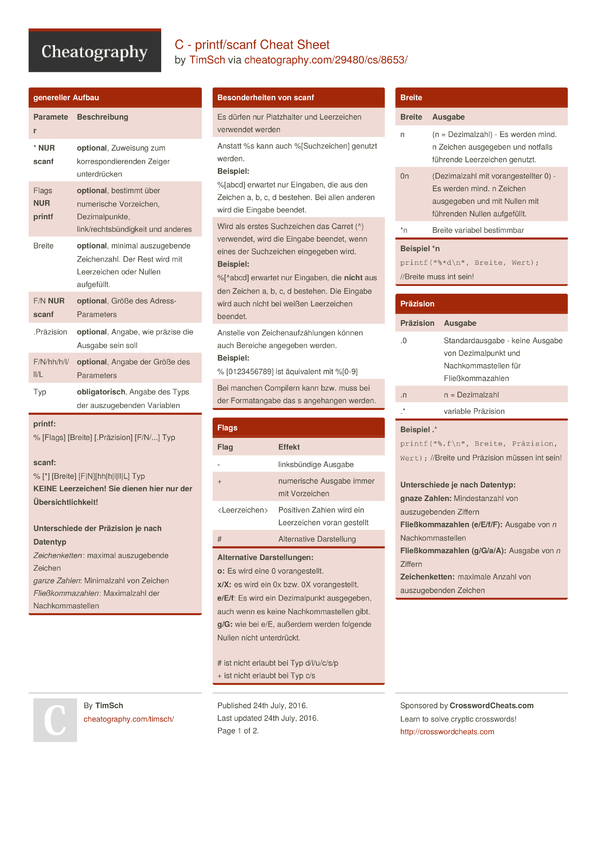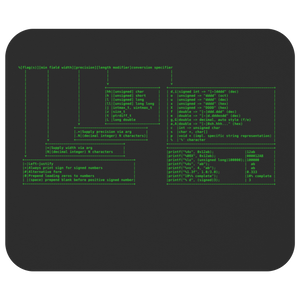- C Printf Cheat Sheet
- Fantasy Football Cheat Sheet
- C Programming Cheat Sheet
- Printf Format String
- Printf Example
- Printf Cheat Sheet
Some function such as printf only get linked if they're called from C/C code, so to call printf from assembly, you need to include at least one call to printf from the C/C too. If you use the MASM assembler, memory accesses must include 'PTR', like 'DWORD PTR rsp'. As I usually print cheat sheets two pages per side and the pack/unpack cheat sheet consumed just one page, I added Perl's printf/sprintf format and attribute summary. Here is how I printed this cheat sheet. Printf statements are just line print statements except the first argument specifies output format. Close( filename ), close( command ) Break connection between print and filename or command.
- The C Standard Library
Getting started Introduction. This is a quick reference to getting started with Bash scripting. Learn bash in y minutes (learnxinyminutes.com); Bash Guide (mywiki.wooledge.org). The C Cheat Sheet Revision 1.0 September 5, 2000. Printf function in the source code since this function is not a part of the core language.
- C Standard Library Resources
- C Programming Resources
- Selected Reading
Description
The C library function int printf(const char *format, ..) sends formatted output to stdout.
Declaration
Following is the declaration for printf() function.
Parameters
format − This is the string that contains the text to be written to stdout. It can optionally contain embedded format tags that are replaced by the values specified in subsequent additional arguments and formatted as requested. Format tags prototype is %[flags][width][.precision][length]specifier, which is explained below −
| Sr.No. | Specifier & Output |
|---|---|
| 1 | c Character |
| 2 | d or i Signed decimal integer |
| 3 | e Scientific notation (mantissa/exponent) using e character |
| 4 | E Scientific notation (mantissa/exponent) using E character |
| 5 | f Decimal floating point |
| 6 | g Uses the shorter of %e or %f |
| 7 | G Uses the shorter of %E or %f |
| 8 | o Signed octal |
| 9 | s String of characters |
| 10 | u Unsigned decimal integer |
| 11 | x Unsigned hexadecimal integer |
| 12 | X Unsigned hexadecimal integer (capital letters) |
| 13 | p Pointer address |
| 14 | n Nothing printed |
| 15 | % Wurth wow 5 00 8 keygen serial. Character |
| Sr.No. | Flags & Description |
|---|---|
| 1 | - Left-justify within the given field width; Right justification is the default (see width sub-specifier). |
| 2 | + Forces to precede the result with a plus or minus sign (+ or -) even for positive numbers. By default, only negative numbers are preceded with a -ve sign. |
| 3 | (space) If no sign is going to be written, a blank space is inserted before the value. |
| 4 | # Used with o, x or X specifiers the value is preceded with 0, 0x or 0X respectively for values different than zero. Used with e, E and f, it forces the written output to contain a decimal point even if no digits would follow. By default, if no digits follow, no decimal point is written. Used with g or G the result is the same as with e or E but trailing zeros are not removed. |
| 5 | 0 Left-pads the number with zeroes (0) instead of spaces, where padding is specified (see width sub-specifier). |
| Sr.No. | Width & Description |
|---|---|
| 1 | (number) Minimum number of characters to be printed. If the value to be printed is shorter than this number, the result is padded with blank spaces. The value is not truncated even if the result is larger. |
| 2 | * 12 week crossfit program pdf. The width is not specified in the format string, but as an additional integer value argument preceding the argument that has to be formatted. |

| Sr.No. | .precision & Description |
|---|---|
| 1 | .number For integer specifiers (d, i, o, u, x, X) − precision specifies the minimum number of digits to be written. If the value to be written is shorter than this number, the result is padded with leading zeros. The value is not truncated even if the result is longer. A precision of 0 means that no character is written for the value 0. For e, E and f specifiers − this is the number of digits to be printed after the decimal point. For g and G specifiers − This is the maximum number of significant digits to be printed. For s − this is the maximum number of characters to be printed. By default all characters are printed until the ending null character is encountered. For c type − it has no effect. When no precision is specified, the default is 1. If the period is specified without an explicit value for precision, 0 is assumed. |
| 2 | .* The precision is not specified in the format string, but as an additional integer value argument preceding the argument that has to be formatted. |

| Sr.No. | Length & Description |
|---|---|
| 1 | h The argument is interpreted as a short int or unsigned short int (only applies to integer specifiers: i, d, o, u, x and X). |
| 2 | l The argument is interpreted as a long int or unsigned long int for integer specifiers (i, d, o, u, x and X), and as a wide character or wide character string for specifiers c and s. |
| 3 | L The argument is interpreted as a long double (only applies to floating point specifiers: e, E, f, g and G). |


additional arguments − Depending on the format string, the function may expect a sequence of additional arguments, each containing one value to be inserted instead of each %-tag specified in the format parameter (if any). There should be the same number of these arguments as the number of %-tags that expect a value.
Return Value
C Printf Cheat Sheet
If successful, the total number of characters written is returned. On failure, a negative number is returned.
Example
The following example shows the usage of printf() function.
Let us compile and run the above program to produce the following result −
- The C Standard Library
- C Standard Library Resources
- C Programming Resources
- Selected Reading
Description
The C library function int printf(const char *format, ..) sends formatted output to stdout.
Declaration
Following is the declaration for printf() function.
Fantasy Football Cheat Sheet
Parameters
format − This is the string that contains the text to be written to stdout. It can optionally contain embedded format tags that are replaced by the values specified in subsequent additional arguments and formatted as requested. Format tags prototype is %[flags][width][.precision][length]specifier, which is explained below −
| Sr.No. | Specifier & Output |
|---|---|
| 1 | c Character |
| 2 | d or i Signed decimal integer |
| 3 | e Scientific notation (mantissa/exponent) using e character |
| 4 | E Scientific notation (mantissa/exponent) using E character |
| 5 | f Decimal floating point |
| 6 | g Uses the shorter of %e or %f |
| 7 | G Uses the shorter of %E or %f |
| 8 | o Signed octal |
| 9 | s String of characters |
| 10 | u Unsigned decimal integer |
| 11 | x Unsigned hexadecimal integer |
| 12 | X Unsigned hexadecimal integer (capital letters) |
| 13 | p Pointer address |
| 14 | n Nothing printed |
| 15 | % Character |
| Sr.No. | Flags & Description |
|---|---|
| 1 | - Left-justify within the given field width; Right justification is the default (see width sub-specifier). |
| 2 | + Forces to precede the result with a plus or minus sign (+ or -) even for positive numbers. By default, only negative numbers are preceded with a -ve sign. |
| 3 | (space) If no sign is going to be written, a blank space is inserted before the value. |
| 4 | # Used with o, x or X specifiers the value is preceded with 0, 0x or 0X respectively for values different than zero. Used with e, E and f, it forces the written output to contain a decimal point even if no digits would follow. By default, if no digits follow, no decimal point is written. Used with g or G the result is the same as with e or E but trailing zeros are not removed. |
| 5 | 0 Left-pads the number with zeroes (0) instead of spaces, where padding is specified (see width sub-specifier). |

| Sr.No. | Width & Description |
|---|---|
| 1 | (number) Minimum number of characters to be printed. If the value to be printed is shorter than this number, the result is padded with blank spaces. The value is not truncated even if the result is larger. |
| 2 | * The width is not specified in the format string, but as an additional integer value argument preceding the argument that has to be formatted. |
| Sr.No. | .precision & Description |
|---|---|
| 1 | .number For integer specifiers (d, i, o, u, x, X) − precision specifies the minimum number of digits to be written. If the value to be written is shorter than this number, the result is padded with leading zeros. The value is not truncated even if the result is longer. A precision of 0 means that no character is written for the value 0. For e, E and f specifiers − this is the number of digits to be printed after the decimal point. For g and G specifiers − This is the maximum number of significant digits to be printed. For s − this is the maximum number of characters to be printed. By default all characters are printed until the ending null character is encountered. For c type − it has no effect. When no precision is specified, the default is 1. If the period is specified without an explicit value for precision, 0 is assumed. |
| 2 | .* The precision is not specified in the format string, but as an additional integer value argument preceding the argument that has to be formatted. |
C Programming Cheat Sheet
| Sr.No. | Length & Description |
|---|---|
| 1 | h The argument is interpreted as a short int or unsigned short int (only applies to integer specifiers: i, d, o, u, x and X). |
| 2 | l The argument is interpreted as a long int or unsigned long int for integer specifiers (i, d, o, u, x and X), and as a wide character or wide character string for specifiers c and s. |
| 3 | L The argument is interpreted as a long double (only applies to floating point specifiers: e, E, f, g and G). |
additional arguments − Depending on the format string, the function may expect a sequence of additional arguments, each containing one value to be inserted instead of each %-tag specified in the format parameter (if any). There should be the same number of these arguments as the number of %-tags that expect a value.
Return Value
Printf Format String
If successful, the total number of characters written is returned. On failure, a negative number is returned.
Printf Example
Example
The following example shows the usage of printf() function.
Let us compile and run the above program to produce the following result −
Printf Cheat Sheet
